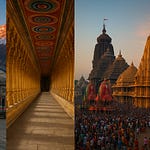The Temple That Breathes Spiritual Immortality
In the sacred city of Kathmandu, nestled on the banks of the Bagmati River, stands one of the most revered temples in the Hindu world – Pashupatinath. This is no ordinary structure of stone and wood; it is a timeless sanctuary where every breath echoes the chant of Lord Shiva and every corner radiates transcendental energy. It is believed that a visit to Pashupatinath absolves one of all sins and guarantees moksha (liberation).
A UNESCO World Heritage Site, this temple is the spiritual heartbeat of Nepal, a symbol of Hindu unity and divine reverence.
Etymology and Meaning: Who is Pashupatinath?
The word ‘Pashupatinath’ is derived from Sanskrit:
‘Pashu’ = animal or living being
‘Pati’ = lord or master
‘Nath’ = protector or god
Hence, Pashupatinath translates to “Lord of all Living Beings.” This is one of the most compassionate avatars of Shiva, where he is not just the destroyer but the sustainer of life, the divine herdsman of all creation.
Origin & Mythological Significance
The Legend of the Cow and the Divine Flame
The origin of Pashupatinath is wrapped in divine mysticism. One popular Hindu myth suggests that Lord Shiva and Goddess Parvati once took the form of antelopes and roamed the forest on the east bank of the Bagmati River. The gods later discovered them and tried to bring them back to their celestial abode. Shiva refused. A scuffle ensued, and in the process, one of Shiva's antelope horns broke and remained buried in the earth. Centuries later, a herdsman saw one of his cows sprinkling milk on the same spot every day. Upon digging the site, the divine lingam (Shiva Lingam) was discovered – thus marking the birth of Pashupatinath.
This lingam is known to emerge and disappear through the cycles of time, reflecting Shiva's formless and eternal nature.
Historical Foundation: Tracing Back the Centuries
Though the exact origin remains veiled in antiquity, historical records trace the current temple structure to the 5th century CE, rebuilt and expanded over centuries by various Nepali kings. The Licchavi King Supuspa Deva is credited with the initial construction.
13th to 17th centuries: The temple received generous patronage from Malla Kings, especially during the golden age of Kathmandu Valley art and architecture.
Post-17th century: Continued renovation and restorations were done by the Shah dynasty and other regional rulers.
The temple has survived earthquakes, invasions, and political changes, standing today as a living, breathing institution of faith.
Temple Architecture: Divine Design in Wood and Gold
The main temple is a two-tiered pagoda with copper and gold roofs.
The lingam inside is a unique Mukhalinga – with four faces (Chaturmukha) pointing in four directions and a fifth on top, symbolizing Shiva’s omnipresence.
Entry into the sanctum sanctorum is restricted to Hindus only.
The temple is surrounded by over 500 smaller shrines, ghats, ashrams, and statues, forming a massive sacred complex.
Notable features include:
Nandi, the Bull: Shiva’s mount, facing the sanctum.
Arya Ghat: Sacred cremation ghat on Bagmati riverbanks.
Gorakhnath Temple, Vasuki Nath, and many tantric shrines add to the spiritual topography.
Puja, Rituals & Daily Worship
Five Times a Day – Shiva is Served
The daily rituals at Pashupatinath follow Tantric, Vedic, and Shaiva traditions:
Morning Abhishek Puja (4:00 AM) – Cleansing of the Shiva Lingam with holy water, milk, ghee, honey, and curd.
Sandhya Aarti (Evening Aarti) – A majestic spectacle of devotion at sunset, performed by priests holding oil lamps, conches, and bells.
Bhasma Puja – Performed with sacred ash to honor Lord Shiva, the cosmic destroyer.
Rudra Abhishekam – Regular chanting of Shiva Rudram with water and bilva leaves.
Nitya Puja – Routine prayers, offerings, and recitations in Sanskrit.
The priests at Pashupatinath are from the South Indian Brahmin community (Bhatta priests) – a tradition started by Adi Shankaracharya to maintain purity.
Bhajans, Mantras, and Spiritual Chanting
The temple atmosphere is alive with Shiva bhajans like:
“Om Namah Shivaya”
“Shiv Tandav Stotra”
“Maha Mrityunjaya Mantra”
“Shivoham Shivoham”
These chants elevate the soul and open pathways to inner peace and divine union. During Shivratri and Teej, mass bhajan gatherings reverberate through the temple grounds.
Mysteries and Esoteric Beliefs
The self-manifested Lingam: Believed to have emerged naturally, not crafted by human hands.
Divine Energy: Yogis claim that even just sitting in meditation near the main temple brings visions and peace.
Cremation Ground Link: Pashupatinath is both a temple and a cremation site, embodying the Shiva principle of life and death as one. Souls who are cremated here are believed to attain moksha instantly.
Festivals at Pashupatinath
1. Maha Shivratri
The grandest celebration, attracting over a million devotees from Nepal, India, Bhutan, and across the world. The temple comes alive with sadhus, aghoris, musicians, and pilgrims, chanting “Har Har Mahadev” through the night.
2. Teej
Primarily observed by Nepali women who fast and pray for marital bliss and family well-being, dressed in red, dancing and singing folk bhajans.
3. Bala Chaturdashi
A unique ritual where devotees scatter seven types of grains (Satbeej) across the forest to honor ancestors.
Spiritual Significance: Why Every Soul Feels Transformed Here
Pashupatinath is more than a religious site. It’s a gateway between life and death, a divine frequency where Shiva’s trident pierces the veil of Maya. It teaches:
Non-attachment – through the sight of cremations
Simplicity and surrender – through the wandering sadhus
Inner power and calm – through the chants and meditation spots
For many, the experience of sitting on the Bagmati’s ghats, watching the sacred rituals unfold, becomes a spiritual awakening.
The Devotee’s Experience: What It Feels Like to Bow Before Pashupatinath
To stand before Pashupatinath, eyes closed, hands folded, is to dissolve the ego. The fragrance of incense, the rhythmic bells, the sacred chants, the sight of Nandi – all form a symphony of surrender. Many devotees describe it as:
“I didn’t just visit a temple… I was reborn.”
People of all castes, colors, and countries walk barefoot here, their heads bowed, shedding tears of bliss. The ghats, the sadhus, the lingam, the chanting – they all come together to create an experience not of this world.
Visiting Pashupatinath: A Spiritual Travel Guide
Location:
Kathmandu, Nepal – near Tribhuvan International Airport
Timings:
Temple open: 4:00 AM to 9:00 PM
Aarti: 6:00 PM (Bagmati River)
Main sanctum access for Hindus only
Best Time to Visit:
February/March – During Maha Shivratri
July/August – Shravan Month
September – Teej Festival
Entry Guidelines:
Only Hindus allowed in the inner sanctum
Non-Hindus can explore outer temples and attend the Bagmati Aarti
Travel Tips:
Remove shoes before entering premises
Dress modestly
Carry Nepali Rupees
Respect cremation rites
Nearby Attractions:
Guhyeshwari Temple – Dedicated to Goddess Sati
Boudhanath Stupa – A center for Tibetan Buddhism
Swayambhunath (Monkey Temple)
Thamel – A vibrant tourist area for food, culture, and shopping
Where Eternity Resides
Pashupatinath is not just a place. It is a portal of cosmic consciousness. It humbles, uplifts, transforms. Whether you're a curious traveler, a spiritual seeker, or a devout Shiva bhakt, this sacred abode leaves an imprint on your soul that transcends lifetimes.
When you leave the temple, you don’t just walk away.
You carry Pashupatinath with you — in your breath, your heartbeat, your silence.










